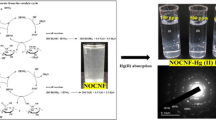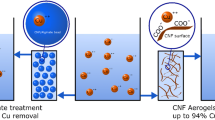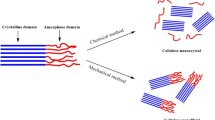Abstract
The study explores the potential of cellulose nanocrystals (CNC), cellulose nanofibers (CNF) and chitin nanocrystals (ChNC) isolated from bioresidues to remove silver ions from contaminated water. Zeta sizer studies showed negatively charged surfaces for CNC and CNF isolated from cellulose sludge in the acidic and alkaline pHs, whereas ChNC isolated from crab shell residue showed either positive or negative charges depending on pH conditions. Model water containing silver ions showed a decrease in Ag+ ion concentration (measured by inductively coupled plasma-optical emission spectrometer; inductively coupled plasma mass spectrometry), after treatment with CNC, CNF and ChNC suspensions. The highest Ag+ ion removal was measured near neutral pH for CNC, being 34.4 mg/g, corresponding to 64 % removal. ChNC showed 37 % and CNF showed 27 % removal of silver ions. The WDX (wavelength dispersive X-ray analysis) and XPS (X-ray photoelectron spectroscopy) analysis confirmed the presence of silver ions on the surface of the nanocellulose and nanochitin after adsorption. Surface adsorption on the nanoparticles via electrostatic interactions is considered to be the prominent mechanism of heavy metal ion capture from aqueous medium, with CNC with negative surface charge and negatively charged functional groups being most favourable for the adsorption of positively charged Ag+ ions compared to other native bionanomaterials.








Similar content being viewed by others
References
Araki J, Wada M, Kuga S, Okano T (1998) Influence of surface charge on viscosity behavior of cellulose microcrystal suspension. J Wood Sci 45:258–261
Arora S, Lal S, Kumar S, Kumar M, Kumar M (2011) Comparative degradation kinetic studies of three biopolymers: chitin, chitosan and cellulose. Arch Appl Sci Res 3:188–201
Azizi MAS, Alloin F, Dufresne A (2005) Review of recent research into cellulosic whiskers, their properties and their application in nanocomposite field. Biomacromolecules 6:612–626
Bondeson D, Mathew AP, Oksman K (2006) Optimization of the isolation of nanocrystals from microcrystalline cellulose by acid hydrolysis. Cellulose 13:171–180
Carol LL, Matthew PH (1999) An investigation into the use of chitosan for the removal of soluble silver from industrial wastewater. Environ Sci Technol 33:3622–3626
Cho YW, Jang J, Park CR, Ko SW (2000) Preparation and solubility in acid and water of partially deacetylated chitins. Biomacromolecules 1:609–614
Chu B, Hsiao BS, Ma HY (2011) U.S. Patent 2011/0198282
Edzwald JK, Malley JP (2011) Water quality and treatment, 6th edn. McGraw-Hill, New York. ISBN 978-0-07-163011-5
Ferraria AM, Boufi S, Battaglini N, Botelho do Rego AM, ReiVilar M (2010) Hybrid systems of silver nanoparticles generated on cellulose surfaces. Langmuir 26:1996–2001
Guibal E (2004) Interactions of metal ions with chitosan-based sorbents: a review. Sep Purif Technol 38:43–74
Herrera MA, Mathew AP, Oksman K (2012) Comparison of cellulose nanowhiskers extracted from industrial bio-residue and commercial microcrystalline cellulose. Matter Lett 71:28–31
http://www.who.int/water_sanitation_health/publications/2012/jmp_report/en/index.html. Accessed March 2012
Jacob DG, William TW (2007) α -chitin nanocrystals prepared from shrimp shells and their specific surface area measurement. Biomacromolecules 8:252–257
Jonoobi M, Mathew AP, Oksman K (2012) Producing low-cost cellulose nanofiber from sludge as new source of raw materials. Ind Crop Prod 40:232–238
Ma H, Hsiao KB, Chu B (2012a) Ultrafine cellulose nanofibers as efficient adsorbents for removal of UO2 2+ in water. ACS Macro Lett 1:213–216
Ma H, Hsiao KB, Chu B (2012b) Nanofibrous microfiltration membrane based on cellulose nanowhiskers. Biomacromolecules 13:180–186
Marchessault RH, Morehead FF, Walter NM (1954) Liquid crystal systems from fibrillar polysaccharides. Nature 184:632–634
Mathew AP, Oksman K (2010) Nanocomposites. In: Kumar SSR (ed) Nanomaterials for the life sciences, 1st edn. Wiley-VCH, Weinheim, pp 53–79
Mathew AP, Thielsman W, Dufresne A (2008) Mechanical properties of nanocomposites from sorbitol plasticized starch and tunicin whiskers. J Appl Polym Sci 109:4065–4074
Mathew AP, Laborie MG, Oksman K (2009) Cross-linked chitosan/chitin crystal nanocomposites with improved permeation selectivity and ph stability. Biomacromolecules 10:1627–1632
Mikkonen K, Mathew AP, Pirkkalainen K, Serimaa R, Xu C, Willför S, Oksman K, Tenkanen M (2010) Glucomannan composite films with cellulose nanowhiskers. Cellulose 17:69–81
Moulder JF, Stickle WF, Sobol PE, Bomben KD (1992) Handbook of X-ray photoelectron spectroscopy. Perkin-Elmer Corp., Eden Prairie, MN
Nair KG, Dufresne A (2003) Crab shell chitin whisker reinforced natural rubber nanocomposites. 1. Processing and swelling behavior. Biomacromolecules 4:657–665
Nishino T, Takano K, Nakamae K (1995) Elastic modulus of the crystalline regions of cellulose polymorphs. J Polym Sci Part B 33:1647–1651
Oksman K, Mathew AP, Bondeson D, Kvien I (2006) Manufacturing process of cellulose whiskers/polylactic acid nanocomposites. Compos Sci Technol 66:2776–2784
Oksman K, Mathew AP, Sain M (2009) Novel bionanocomposites: processing, properties and potential applications. Plast Rubber Compos 38:396–405
Rinaudo M (2006) Chitin and chitosan: properties and applications. Prog Polym Sci 31:603–632
Segal L, Greely JJ, Martin AE, Conrad CM (1959) An empirical method for estimating the degree of crystallinity of native cellulose using X-ray diffractometer. Text Res J 29:786–794
Sehaqui H, Zhou Q, Ikkala O, Berglund LA (2011) Strong and tough cellulose nanopaper with high specific surface area and porosity. Biomacromolecules 12:3638–3644
Servicio Nacional de Pesca (SERNAPESCA) (2001) Valparáıso, Chile, Annual Report 2001, pp 1–3
Sturkova A, Davies GR, Eichorn SJ (2005) Elastic modulus and stress-transfer properties of tunicate cellulose whiskers. Biomacromolecules 6:1055–1061
Tang WK, Neill WK (1964) Effect of flame-retardants on pyrolysis and combustion of α-cellulose. J Poly Sci Part C 6:65–81
Tashiro K, Kobayishi M (1991) Theoretical evaluation of three-dimensional elastic constants of native and regenerated celluloses: role of hydrogen bonds. Polymer 32:1516–1521
Thomas WP, Jennifer JP (1998) Sources of silver in the environment. Environ Toxicol Chem 17:539–546
Uetani K, Yano H (2011) Nanofibrillation of wood pulp using a high-speed blender. Biomacromolecules 12:348–353
Uzum C, Shahwan T, Eroglu AE, Hallam KR, Scott TB, Lieberwirth I (2009) Synthesis and characterization of kaolinite-supported zero-valent iron nanoparticles and their applications for the removal of aqueous Cu2+ and Co2+ ions. Appl Clay Sci 43:172–181
Wang SG, Gong WX, Liu XW, Yao YW, Gao BY, Yue QY (2007) Removal of lead (II) from aqueous solutions by adsorption onto manganese oxide-coated carbon nanotubes. Sep Purif Technol 58:17–23
WHO (2011) Guidelines for drinking-water quality, 4th edn. ISBN: 9789241548151. http://www.who.int/water_sanitation_health/publications/2011/dwq_chapters/en/. Accessed March 2012
WHO, UNICEF (2012) Progress on drinking water and sanitation updated Report in 2012. ISBN: 978 92 806 4632 0
Acknowledgments
The authors gratefully acknowledge the financial support of the European Commission, under the NanoSelect Project, EU FP7-NMP4-SL-2012-280519. We thank Mattias Grahn, Luleå University of Technology, for support with zeta potential studies and helpful discussions.
Author information
Authors and Affiliations
Corresponding author
Electronic supplementary material
Below is the link to the electronic supplementary material.
Rights and permissions
About this article
Cite this article
Liu, P., Sehaqui, H., Tingaut, P. et al. Cellulose and chitin nanomaterials for capturing silver ions (Ag+) from water via surface adsorption. Cellulose 21, 449–461 (2014). https://doi.org/10.1007/s10570-013-0139-5
Received:
Accepted:
Published:
Issue Date:
DOI: https://doi.org/10.1007/s10570-013-0139-5




